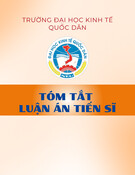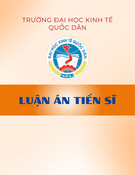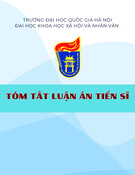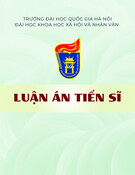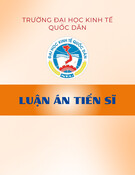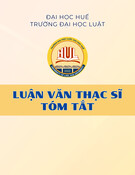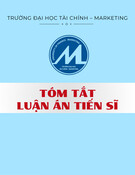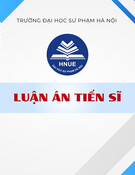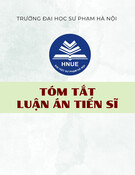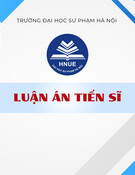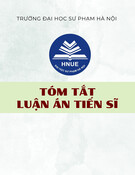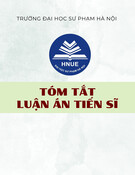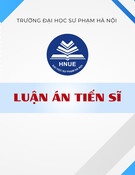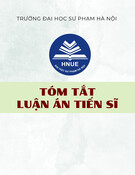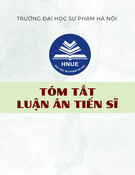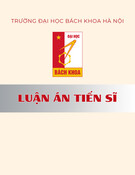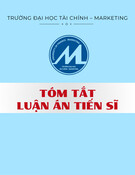
HO CHI MINH NATIONAL ACADEMY OF
POLITICS AND PUBLIC ADMINISTRATION
---------------------------
NGUYEN THI HONG LAM
TOURISM ECONOMY IN THE NORTH CENTRAL
REGION IN INTERNATIONAL ECONOMIC
INTEGRATION
Specialism : Political economics
Code : 62 31 01 01
SUMMARY OF DOCTORIAL (PhD) THESIS IN ECONOMICS
HA NOI – 2013

The thesis is completed at the
Ho Chi Minh National Academy of
Politics and Public Administration
Academic Supervisor: Assoc. Prof. Dr. An Nhu Hai
Judge 1:
Judge 2:
Judge 3:
The thesis will be defended in front of a panel of examining judges at
Ho Chi Minh National Academy of Politics and Public Administration
At date month 2013
The thesis is available at: National Library
and Library of the Ho Chi Minh National Academy of
Politics and Public Administration

1
INTRODUCTION
1. The necessity of the research
Tourism is a synthetic industry which is highly intersectoral, interregional and
socialised. Performances of this industry not only meets the rising demand for travel
of human beings but also plays an essential role in the ”on-the-spot export” of goods
and services abroad.
In Vietnam, the tourism industry came into being in 1960, however, until
1990s it was regarded as an economy soon after the country’s open door policy. Since
then, the tourism economy has grown rapidly and attained certain encouraging
achievements.
The North Central region is an economic zone consisting of Thanh Hoa, Nghe
An, Ha Tinh, Quang Binh, Quang Tri and Thua Thien-Hue provinces, abounding in
many valuable tourism potentials with diverse natural wonders and cultural identities.
On the other hand, favourable traffic conditions regarding road, rail and waterway
transport facilitates the region’s tourism economy to bring into full play its
advantages and attract tourists.
Over the past years, tourism economy in the North Central provinces has made
a remarkable growth. Nevertheless, the current development of the tourism economy
remains limited in regard to demands for international economic integration and the
region’s potential. The matter here is how to tap into full potential and advantages of
the tourism economy in the whole region to satisfy the demands for international
economic integration to bring about high socio-economic effects? Under such
circumstances, that the PhD candidate chooses the topic: “Tourism economy in the
North Central provinces in international economic integration” which is of not
only theoretical but also practical significance to the development of tourism
economy in the North Central provinces in the coming time.
2. Purpose and task of the research
- Purpose: To accelerate the development of tourism economy in the North
Central provinces in the context of Vietnam’s deeper and greater integration in
international economic relations from the point of political economics.
- Task: 1) To systemize theoretical and practical foundations of tourism
economy in international economic integration of a certain territory in Vietnam from
the point of political economics, 2) To evaluate the reality of tourism economy in
international economic integration in the North Central provinces, and 3) To propose
directions and solutions to promote the development of tourism economy in the North
Central provinces in international economic integration.
3. Subject and scope of the research:

2
- Subject of the research: All business activities related to tourism economy in
the North Central provinces in international economic integration.
- Scope of the research:
+ Space: The thesis studies tourism economy in the North Central provinces
from economic approaches. The thesis does not study each province individually but
considers each province’s tourism economy as a component of tourism economy of
the whole North Central region.
+ Time scope: The situation of tourism economy from 2000 to the present;
directions and solutions to 2020 with a vision to 2030.
4. Theoretical foundations and research methods of the thesis
- Theoretical foundations:
The Marxism - Leninism, Ho Chi Minh ideology, and standpoints, paths,
renewal policies of the Party and State of Vietnam in regard to tourism economy
development.
- Research methods:
+ Research methods applied include abstractisation, analysis and synthesis, and
logic plus historical background, statistical method, quantitative analysis, and comparative
method; and selectively acquires some results of published scientific studies.
5. Scientific contributions and values of the thesis
1) Systemizing theories of tourism economy in international economic
integration in a certain tourism area in Vietnam from the perspective of political
economics. 2) Selecting lessons drawn from foreign countries’ experience in
developing tourism economy to refer to the case of Vietnam in general and the case
of the North Central region in particular. 3) Assessing the situation of tourism
economy, the thesis analyzes achievements and shortcomings of tourism economy in
the North Central provinces in international economic integration.
6. Conclusion
Besides the introduction, conclusion, list of reference, and appendix the thesis
comprises four chapters and eleven sections.
Chapter 1
OVERVIEW OF RESEARCH ON TOURISM ECONOMY
1.1. FOREIGN STUDIES ON TOURISM ECONOMY
A number of typical foreign researches focusing on tourism and tourism
economy include: 1) The book “Tourism in Developing Countries” by Martin
Oppermann and Kye - Sung Chon, was published in 1997 by International Thomson
Business Press. 2) The research:“The Business of Rural Tourism International
Perspectives” by co-authors Stephen J. Page and Don Getz, was printed by
International Thomson Business Press in 1997. 3) The research: “Commercial

3
Recreation & Tourism - An Introduction to Business Oriented Recreation” by Susan
A.Weston, was printed in 1996 by Brown & Benchmark. 4) The research: “Managing
Tourism” was written in 1991 by Prof. S. Medlik and reprinted in 1995 by
Butterworth - Heinemann. 5) The work: “The Economics of Leisure and Tourism” by
John Tribe was published by Butterworth - Heinemann Ltd in 1995, etc.
1.2. DOMESTIC RESEARCHES ON TOURISM ECONOMY
1.2.1. Scientific researches and PhD theses
There has been a great number of researches on tourism and tourism economy
in Vietnam so far. Regarding these areas, it should be noted the scientific researches
and PhD theses as followed: 1) Ministerial-leveled work (2007): “Research develops
Vietnam’s tourism products of high competitiveness in the region and in the world”,
is carried out by a group of authors, led by Dr. Do Cam Tho, from the Institute for
Tourism Development Research. 2) Ministerial-level research (2008):“Scientific
ground to develop coastal tourism in the North Central region”, is carried out by a
group of authors led by Assoc Prof. and Dr. Pham Trung Luong of the National
Institute for Tourism Development Research. 3) Ministerial-level research (2011)
“The status quo of and solutions to develop national sea tourism regions in the North
Central region”, is carried out by a group of authors led by Dr. Nguyen Thu Hanh, of
the Institute for Tourism Development Research. 4) The Vietnam National
Administration of Tourism’s research: “Policy and solutions to promote tourism
development in the central and Central Highlands region” (2001). 5) The report:
“Master plan on tourism development in the North Central region to 2020, with a
vision to 2030” (2012) by the Ministry of Culture, Sports and Tourism. 6) Thesis of
economics by Hoang Thi Ngoc Lan of the Ho Chi Minh National Academy of
Politics and Public Administration, Ha Noi (2007), “Ha Tay’s tourism market”, etc.
1.2.2. Researches in the form of books and other publications
Among these publications, those focusing tourism and tourism economy so far
include: 1) The book “Tourism market” by Nguyen Van Luu, Ha Noi National
Publishing House, 2009. 2) The “Tourism economy syllabus” book is written by Prof.,
Dr. NguyenVan Dinh and Assoc. Prof., Dr. Nguyen Van Dinh and published by the
National Economics University, Ha Noi, in 2008. 3) The “Travel Business
Management Syllabus” text book by co-authors Assoc. Prof., Dr. Nguyen Van Manh
and Assoc. Prof., Dr. Pham Hong Chuong, National Economics University’s
Publishing House, Ha Noi, 2009, etc. In addition, on the national scientific research
forum there are numerous articles related to tourism economy in the context of
international economic integration, notably: “Tourism Development in the North
Central Region: Issues raised”(2010) by Assoc. Prof., Dr. Pham Trung Luong at the
workshop on “Orientations of Tourism Development in the North Central Region”

